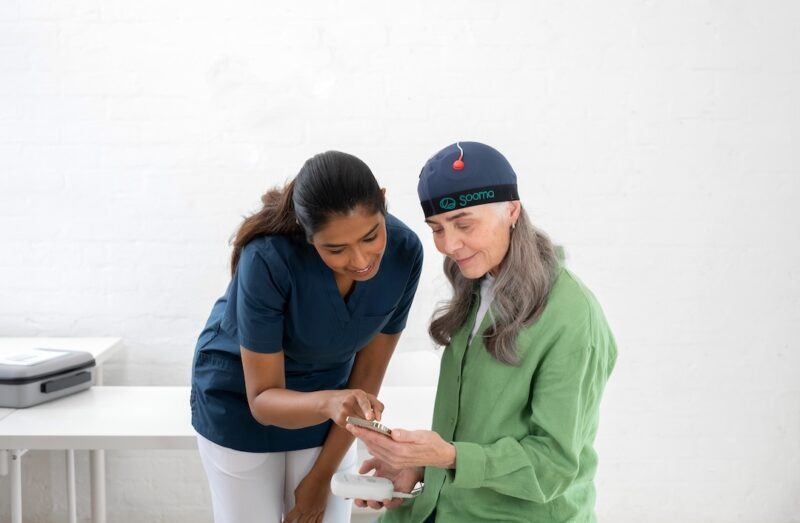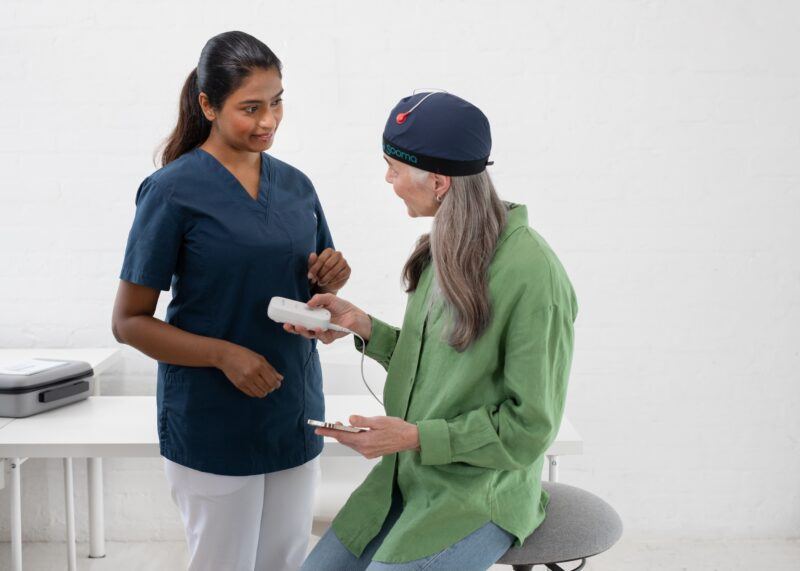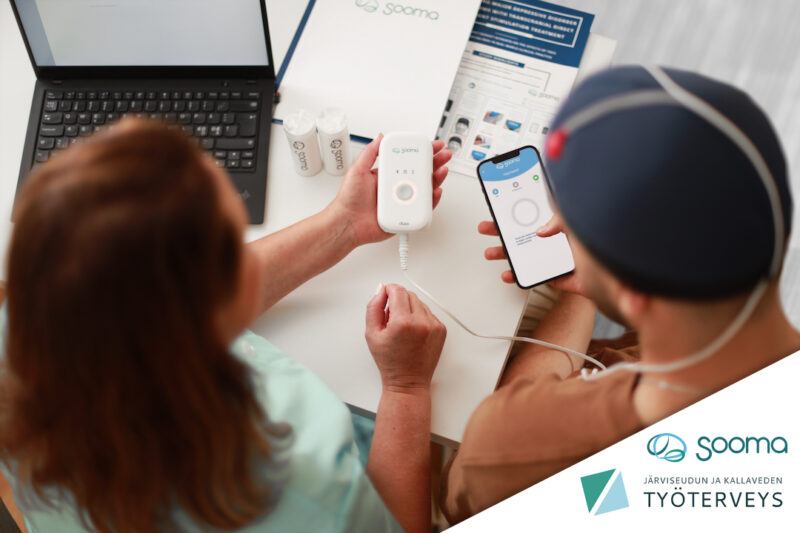5 evidence-based factors for effective depression treatment with tDCS

This post is an updated version (especially the snapshot of clinical evidence) of a post we published on 17.05.2017. The post is based on a 2016 meta-analysis by Brunoni et al, which we to this day we still find it very insightful and relevant. Enjoy!
Transcranial direct current stimulation (tDCS) can be an effective treatment method for Major Depressive Disorder (MDD).
A snapshot of clinical evidence:
- Level A evidence (= definitely effective) in the international evidence-based guidelines, published in 2020 by a large group of leading European experts.
- 61% response rate and 20% remission rate in 302 patients treated for MDD with the Sooma tDCS device (Sooma White paper).
- 33% response rate and 19% remission rate in a 1,092-patient clinical trial.
- Similar effect size to those reported for transcranial magnetic stimulation (TMS) and antidepressant drug treatment in primary care.
- 43% response rate as a mono-treatment, and 63% response rate when combined with sertraline, in a 120-patient trial.
But as a follower of tDCS research, you’ll know that both research studies and clinical routine results can have a lot of variance to them. Why is this the case?
The simple answer is, it’s complicated.
Both tDCS and depression are so multifaceted in nature that interactions between different factors potentially impacting treatment result seem to be all over the place. Trying to make sense of what’s going on so you can give the right treatment to the right patient may seem almost like a lost cause.
But there is hope:
A 2016 meta-analysis based on individual patient data by Brunoni et al. not only investigated the efficacy of tDCS for depression treatment but also explored individual response predictors.
In this article, we present a list of five evidence-based factors that affect patients’ response to tDCS-treatment for depression based on this meta-analysis.
What factors predict response to tDCS-treatment for depression?
Let’s start by simply naming the factors. If you’re a busy reader, you may just read this section, bookmark this article and come back to read the details below later.
- Treatment-resistant depression (TRD) is a predictor of poor response to tDCS. TRD is defined as two or more failed antidepressant trials.
- Greater total tDCS dose (to an extent) is a predictor for better response.
- Bipolar depression patients may respond better to tDCS treatment than unipolar depression patients.
- Adjunct use of sertraline, as mentioned in the introduction, is associated with faster and greater depression improvement.
- Severe depression may be a predictor for better response. Be careful with this one. Although there is some evidence for this, it may be impacted by confounding factors. Here at Sooma, we actually think that the opposite may be true, in part because severely depressed patients are so often also treatment-resistant.
More detail on each of these variables follows in the sections below.
1 Treatment-resistant depression (TRD)
Treatment-resistant depression (defined as two or more failed antidepressant trials) is strongly associated with lower tDCS efficacy. Optimal use of tDCS could, therefore, be at an earlier point in the treatment chain, for example, in a primary care setting, before TRD sets in.
TRD patients are more than 60% less likely to benefit from tDCS-treatment compared to non-TRD patients based on the available data.
This predictive variable was included and remained statistically significant in both the clinical response and depression improvement analyses (see the “Statistical background” section below for more information).
This same phenomenon has been observed in studies for pharmacotherapy, rTMS and electroconvulsive therapy (ECT) as well.
2 tDCS dose
Higher total tDCS dose, defined as the product of stimulation current, session duration, and number of sessions, is a predictor of treatment response and depression improvement.
It’s important to mention that session duration by itself (20 minutes vs. 30 minutes) was also a statistically significant predictor of treatment response. Stimulation current, on the other hand, was not.
Patients receiving a total dose of 43.2 C, as per a protocol consisting of 12 sessions of 2 mA stimulation for 30 minutes, are more than 5 times more likely to respond than those receiving an even slightly lower total dose (the equivalent of missing two such sessions), and the difference in benefit becomes even greater compared to doses that are lower still.
No protocols with stimulation currents greater than 2 mA or durations greater than 30 minutes have been used in controlled trials.
Like TRD, tDCS dose was also included and remained significant in both the clinical response and depression improvement analyses. As for analogies with other treatment modalities, higher-dose protocols have also been shown to increase the efficacy of rTMS therapy.
3 Bipolar depression patients
The results of the predictive variables analyses suggest that bipolar depression patients are more likely to respond to tDCS treatment.
However, more data is needed to fully verify this, as the number of bipolar patients was low, and several studies included in the meta-analysis had protocols that explicitly excluded bipolar patients.
This is reflected by the large confidence interval (CI) for the odds ratio (OR) of this variable’s predictive ability. OR (bipolar vs. not) of response = 6.60; CI = 1.05-41.7; p=0.04.
Bipolar depression was statistically significant in the multivariate analysis for depression improvement and in univariate analyses, but not in the multivariate analysis for clinical response.
4 Sertraline augmentation
Although adjunct antidepressant use, in general, was not found to be associated with greater tDCS efficacy, adjunct use of sertraline, in particular, was shown to lead to faster and greater depression improvement.
However, since all data on this variable comes from a single study, it would be premature to draw any definitive conclusions. Sertraline augmentation was statistically significant in the same models as bipolar depression (see above).
5 Depression severity
The data from the meta-analysis showed that more severely depressed patients (that are still non-TRD), may respond better to tDCS.
This is somewhat contrary to our experience and may be a “statistical artefact associated with clinical trial design” as pointed out by the researchers.
This kind of statistical artefacts relates to the fact that there simply is more room for improvement when the baseline depression level is high. An antidepressant meta-analysis has previously had the same finding.
Nonetheless, it’s worth keeping an eye on this variable (or better yet, logging data meticulously), and see how your patients of various depression levels seem to respond to tDCS.
Like the previous two predictive variables, baseline depression was statistically significant in the multivariate analysis for depression improvement and in univariate analyses, but not in the multivariate analysis for clinical response.
Statistical background
You may wonder what these proposed treatment-response associated factors are based on.
As mentioned in the introduction, the data comes from a meta-analysis by psychiatrist André Brunoni and colleagues. The meta-analysis is based on individual patient data from all randomised controlled tDCS-trials in depression for which such data was available.
In total, six trials with 289 patients were included in the analysis.
Three kinds of prediction models were used, investigating response (>50% depression improvement), remission, and depression improvement (as a continuous variable).
More details on the statistical methods used
First, the researchers used univariate analyses using one predictor variable at a time. Variables that were measured in all studies and reached statistical significance in the univariate analyses (P<0.1 significance level) were then included in multivariate analyses.
In the multivariate analyses, the input predictors were successively removed if they were not significant (P<0.05 significance level) using the stepwise backward method. The best fits were chosen based on the Wald statistics.
The data presented above comes from both the multivariate models for depression response (TRD and tDCS dose) and the multivariate model for depression improvement (TRD, tDCS dose, bipolar disorder, severe depression, and sertraline augmentation).
It’s harder to achieve response than depression improvement. And there’s more nuanced data available for depression improvement since it’s a continuous variable, not a binary one. Because of this, only the variables with the strongest statistical power will qualify for inclusion in the models predicting response, compared to depression improvement.
What does this mean in plain English?
It means that TRD and tDCS dose are the variables most likely to represent true predictors of tDCS-treatment results. These are the only variables that ultimately were included in the multivariate response model.
Conclusion
And there you have it. Among the many factors that may impact tDCS treatment response, treatment-resistant depression, total tDCS dose, bipolar depression, adjunct sertraline treatment, and depression severity are the ones that have research data in any larger quantity behind them to back them up.
It should be said that these may change as more research studies are done. They’re certainly not set in stone yet.
That said, it’s likely that number one and two on this list, TRD and tDCS dose, will remain. The contributions to the several models predicting response or depression improvement that these variables made were both large and significant.
So the takeaway message for medical professionals would be:
- Treatment-resistant patients are much less likely to respond to tDCS.
- The tDCS dose delivered over the treatment protocol should be at least equivalent to 12 sessions of 30 minutes with 2 mA. An equivalent but different protocol would be 18 sessions of 30 minutes at 1.5 mA.
- Bipolar depression patients may respond better to tDCS than unipolar patients. More data is needed to verify this.
- Sertraline augmentation looks likely to be beneficial for improved response. But be aware that all data comes from one single, albeit large (N = 120) study.
- Finally, more severely depressed patients may respond better to tDCS treatment. This finding may be a consequence of clinical trial design rather than an actual phenomenon, though.
If you want more information like this, be sure to subscribe to our newsletter. That’s where we share the latest news in the world of tDCS and depression with thousands of psychiatrists and medical professionals.
Latest news

TGA approves Sooma’s at-home brain stimulation for depression in Australia
Read more
Sooma Medical Announces Pivotal FDA IDE Clinical Trial for At-Home Brain Stimulation Device for Depression Treatment
Read more
Sooma Pioneers the Integration of Brain Stimulation into Primary Care, Improving Access to Early-Stage Depression Treatment
Read more